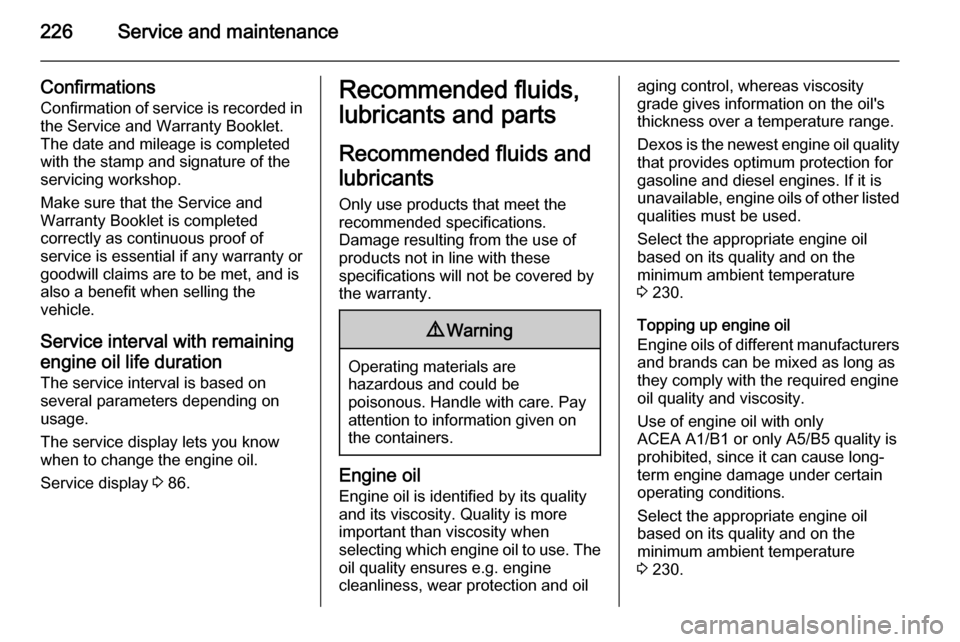display VAUXHALL CASCADA 2015 Repair Manual
[x] Cancel search | Manufacturer: VAUXHALL, Model Year: 2015, Model line: CASCADA, Model: VAUXHALL CASCADA 2015Pages: 251, PDF Size: 7.47 MB
Page 172 of 251

170Driving and operating
FaultThe traffic sign assistant system may
not operate correctly when:
■ the area of the windscreen, where the front camera is located, is notclean
■ traffic signs are completely or partially covered or difficult to
discern
■ there are adverse environmental conditions, e.g. heavy rain, snow,
direct sunlight or shadows. In this
case No Traffic Sign Detection due
to Weather is indicated on the
display
■ traffic signs are incorrectly mounted
or damaged
■ traffic signs do not comply with the Vienna Convention on traffic signs
(Wiener Übereinkommen über
Straßenverkehrszeichen)Caution
The system is intended to help the driver within a defined speed
range to discern certain traffic
signs. Do not ignore traffic signs
which are not displayed by the
system.
The system does not discern any other than the conventional traffic
signs that might give or end a
speed limit.
Do not let this special feature
tempt you into taking risks when
driving.
Always adapt speed to the road
conditions.
The driver assistance systems do not relieve the driver from full
responsibility for vehicle
operation.
Lane departure warning
The lane departure warning systemobserves the lane markings between
which the vehicle is driving via a front camera. The system detects lane
changes and warns the driver in the
event of an unintended lane change
via visual and acoustic signals.
Criteria for the detection of an
unintended lane change are:
■ no operation of turn signals
■ no brake pedal operation
■ no active accelerator operation or speeding-up
■ no active steering
If the driver is performing these
actions, no warning will be issued.
Activation
The lane departure warning system isactivated by pressing the ) button.
The illuminated LED in the button
indicates that the system is switched
Page 202 of 251

200Vehicle care
No.Circuit1Displays2Body control unit, exterior lights3Body control unit, exterior lights4Infotainment system5Infotainment system, instru‐
ment6Power outlet, cigarette lighter7Power outlet8Body control module, left low
beam9Body control module, right low
beam10Body control module, door locks11Interior fan12Driver power seat13Passenger power seat14Diagnostic connector15AirbagNo.Circuit16Boot lid relay17Air conditioning system18Service diagnose19Body control module, brake
lights, tail lights, interior lights20-21Instrument panel22Ignition system23Body control module24Body control module25–26Trunk power outlet accessory
Load compartment fuse
box
The fuse box is on the left side of the
load compartment behind a cover.
Remove the cover.
Fuse assignments
Page 207 of 251

Vehicle care205
The current tyre pressures can be
shown in the Vehicle Information
Menu in the Driver Information Centre
(DIC).
The menu can be selected by the
buttons on the turn signal lever.
Press the MENU button to select the
Vehicle Information Menu X.
Turn the adjuster wheel to select the
tyre pressure monitoring system.
System status and pressure warnings
are displayed by a message with the
corresponding tyre flashing in the
DIC.A detected low tyre pressure
condition is indicated by the control
indicator w 3 93.
If w illuminates, stop as soon as
possible and inflate the tyres as
recommended 3 238.
If w flashes for 60-90 seconds and
then illuminates continuously, there is a fault in the system. Consult a
workshop.
After inflating, driving may be
required to update the tyre pressure
values in the DIC. During this time w
may illuminate.
Page 208 of 251

206Vehicle care
If w illuminates at lower temperatures
and extinguishes after some driving,
this could be an indicator for getting low pressure. Check tyre pressure.
Vehicle messages 3 101.
If the tyre pressure must be reduced
or increased, switch off ignition.
Only mount wheels with pressure
sensors, otherwise the tyre pressure
will not be displayed and w
illuminates continuously.
A temporary spare wheel is not
equipped with pressure sensors. The
tyre pressure monitoring system is
not operational for these wheels.
Control indicator w illuminates. For
the further three wheels the system
remains operational.
The use of commercially available
liquid tyre repair kits can impair the
function of the system. Factory-
approved repair kits can be used.
External high-power radio equipment
could disrupt the tyre pressure
monitoring system.Each time the tyres are replaced, tyre
pressure monitoring system sensors
must be dismounted and serviced.
For the screwed sensor: replace
valve core and sealing ring. For
clipped sensor: replace complete
valve stem.
Vehicle loading statusAdjust tyre pressure to load condition
according to tyre information label or
tyre pressure chart 3 238, and select
the relevant setting in the menu Tire
Load in the DIC, Vehicle Information
Menu 3 95.Select:
■ Light for comfort pressure up to
3 people
■ Eco for Eco pressure up to
3 people
■ Max for full loading
TPMS Sensor Matching
Process
Each TPMS sensor has a unique
identification code. The identification
code must be matched to a new tyre/
wheel position after rotating the tyres
or exchanging the complete wheel set and if one or more TPMS sensors
were replaced. The TPMS sensor matching process should also be
performed after replacing a spare tyre
with a road tyre containing the TPMS
sensor.
The malfunction light and the warning
message or code should go off at the
next ignition cycle. The sensors are
matched to the tyre/wheel positions,
using a TPMS relearn tool, in the
following order: left side front tyre,
right side front tyre, right side rear tyre
Page 209 of 251

Vehicle care207
and left side rear tyre. The turn signal
light at the current active position is
illuminated until sensor is matched.
Consult your workshop for service or
to purchase a relearn tool. There are
two minutes to match the first tyre/
wheel position, and five minutes
overall to match all four tyre/wheel positions. If it takes longer, the
matching process stops and must be
restarted.
The TPMS sensor matching process
is:
1. Apply the parking brake; on vehicles with automatic
transmission set the selector lever
to P.
2. Turn the ignition on.
3. Use the MENU button on the turn
signal lever to select the Vehicle
Information Menu in the Driver
Information Centre (DIC).
4. Turn the adjuster wheel to scroll to
the tyre pressure menu.5. Press the SET/CLR button to
begin the sensor matching
process. A message requesting
acceptance of the process should
display.
6. Press the SET/CLR button again
to confirm the selection. The horn sounds twice to signal the
receiver is in relearn mode.
7. Start with the left side front tyre.
8. Place the relearn tool against the tyre sidewall, near the valve stem.Then press the button to activate
the TPMS sensor. A horn chirp
confirms that the sensor
identification code has been
matched to this tyre and wheel
position.
9. Proceed to the right side front tyre,
and repeat the procedure in Step 8.
10. Proceed to the right side rear tyre,
and repeat the procedure in
Step 8.
11. Proceed to the left side rear tyre, and repeat the procedure in
Step 8. The horn sounds twice toindicate the sensor identification
code has been matched to the left
side rear tyre, and the TPMS
sensor matching process is no
longer active.
12. Turn off the ignition.
13. Set all four tyres to the recommended air pressure level
as indicated on the tyre pressure
label.
14. Ensure the tyre loading status is set according selected pressure
3 95.
Temperature dependency
Tyre pressure depends on the
temperature of the tyre. During
driving, tyre temperature and
pressure increase.
The tyre pressure value displayed in
the DIC shows the actual tyre
pressure. Therefore it is important to
check tyre pressure with cold tyres.
Tread depth
Check tread depth at regular
intervals.
Page 225 of 251

Vehicle care223
For mechanical removal of ice, use a
sharp-edged ice scraper. Press the
scraper firmly against the glass so
that no dirt can get under it and
scratch the glass.
Remove dirt residues from smearing
wiper blades by using a soft cloth and window cleaner. Also make sure to
remove any residues such as wax,
insect residues and similar from the
window.
Ice residues, pollution and continuous
wiping on dry windows will damage or
even destroy the wiper blades.
Wheels and tyres
Do not use high-pressure jet
cleaners.
Clean rims with a pH-neutral wheel
cleaner.
Rims are painted and can be treated
with the same agents as the body.
Paintwork damage Rectify minor paintwork damage with
a touch-up pen before rust forms.
Have more extensive damage or rust
areas repaired by a workshop.Underbody
Some areas of the vehicle underbody
have a PVC undercoating while other
critical areas have a durable
protective wax coating.
After the underbody is washed, check
the underbody and have it waxed if
necessary.
Bitumen/rubber materials could
damage the PVC coating. Have
underbody work carried out by a
workshop.
Before and after winter, wash the
underbody and have the protective
wax coating checked.
Towing equipment
Do not clean the coupling ball bar with a steam-jet or high-pressure jet
cleaner.
Interior care Interior and upholstery
Only clean the vehicle interior,
including the instrument panel fascia
and panelling, with a dry cloth or
interior cleaner.Clean the leather upholstery with
clear water and a soft cloth. In case of heavy soiling, use leather care.
The instrument cluster and the
displays should only be cleaned using
a soft damp cloth. If necessary use a
weak soap solution.
Clean fabric upholstery with a
vacuum cleaner and brush. Remove
stains with an upholstery cleaner.
Clothing fabrics may not be
colourfast. This could cause visible discolourations, especially on light-
coloured upholstery. Removable
stains and discolourations should be
cleaned as soon as possible.
Clean seat belts with lukewarm water or interior cleaner.Caution
Close Velcro fasteners as open
Velcro fasteners on clothing could damage seat upholstery.
The same applies to clothing with
sharp-edged objects, like zips or
belts or studded jeans.
Page 227 of 251

Service and maintenance225Service and
maintenanceGeneral information ...................225
Recommended fluids, lubricants and parts .................................... 226General information
Service information In order to ensure economical and
safe vehicle operation and to
maintain the value of your vehicle, it
is of vital importance that all
maintenance work is carried out at the proper intervals as specified.
The detailed, up-to-date service
schedule for your vehicle is available
at the workshop.
Service display 3 86.
European service intervals
Maintenance of your vehicle is
required every 20,000 miles or after
1 year , whichever occurs first, unless
otherwise indicated in the service
display.
A shorter service interval can be valid for severe driving behaviour, e.g. for
taxis and police vehicles.
The European service intervals are
valid for the following countries:Andorra, Austria, Belgium, Bosnia-
Herzegovina, Bulgaria, Croatia,
Cyprus, Czech Republic, Denmark,
Estonia, Finland, France, Germany,
Greece, Greenland, Hungary,
Iceland, Ireland, Italy, Latvia,
Lithuania, Luxembourg, Macedonia,
Malta, Montenegro, Netherlands,
Norway, Poland, Portugal, Romania,
Serbia, Slovakia, Slovenia, Spain,
Sweden, Switzerland, United
Kingdom.
Service display 3 86.
International service intervals Maintenance of your vehicle is
required every 10,000 miles or after
1 year , whichever occurs first, unless
otherwise indicated in the service
display.
The international service intervals are
valid for the countries which are not
listed in the European service
intervals.
Service display 3 86.
Page 228 of 251

226Service and maintenance
Confirmations
Confirmation of service is recorded in the Service and Warranty Booklet.The date and mileage is completed
with the stamp and signature of the servicing workshop.
Make sure that the Service and
Warranty Booklet is completed
correctly as continuous proof of
service is essential if any warranty or goodwill claims are to be met, and is
also a benefit when selling the
vehicle.
Service interval with remaining engine oil life duration The service interval is based on
several parameters depending on
usage.
The service display lets you know
when to change the engine oil.
Service display 3 86.Recommended fluids,
lubricants and parts
Recommended fluids and
lubricants Only use products that meet the
recommended specifications.
Damage resulting from the use of
products not in line with these
specifications will not be covered by
the warranty.9 Warning
Operating materials are
hazardous and could be
poisonous. Handle with care. Pay
attention to information given on
the containers.
Engine oil
Engine oil is identified by its quality
and its viscosity. Quality is more
important than viscosity when
selecting which engine oil to use. The oil quality ensures e.g. engine
cleanliness, wear protection and oil
aging control, whereas viscosity
grade gives information on the oil's
thickness over a temperature range.
Dexos is the newest engine oil quality
that provides optimum protection for gasoline and diesel engines. If it is
unavailable, engine oils of other listed qualities must be used.
Select the appropriate engine oil
based on its quality and on the
minimum ambient temperature
3 230.
Topping up engine oil
Engine oils of different manufacturers
and brands can be mixed as long as
they comply with the required engine
oil quality and viscosity.
Use of engine oil with only
ACEA A1/B1 or only A5/B5 quality is
prohibited, since it can cause long-
term engine damage under certain
operating conditions.
Select the appropriate engine oil
based on its quality and on the
minimum ambient temperature
3 230.
Page 247 of 251

245
Clock............................................. 81
Code ........................................... 101
Control indicators.......................... 87
Control of the vehicle .................132
Controls ........................................ 77
Convex shape .............................. 29
Coolant and antifreeze ...............226
Cruise control ...................... 94, 150
Cupholders .................................. 70
Curve lighting.............................. 113
D Danger, Warnings and Cautions ...3
Daytime running lights ...............113
Declaration of conformity ............240
Diesel fuel system bleeding .......187
Diesel particle filter ...............92, 138
Door open .................................... 94
Doors ............................................ 24
Driver assistance systems ..........150
Driver Information Centre .............95
Driving characteristics and towing tips .............................. 174
Driving hints ................................ 132
E
Electric adjustment ......................29
Electrical system......................... 196
Electric parking brake ...........91, 144
Electric parking brake fault ...........91Electronic climate control system 125
Electronic driving programmes ..141
Electronic Stability Control.......... 147
Electronic Stability Control and Traction Control system ............92
Electronic Stability Control off....... 92
End-of-life vehicle recovery .......181
Engine compartment fuse box ...197
Engine coolant ........................... 184
Engine coolant temperature gauge ....................................... 86
Engine data ............................... 233
Engine exhaust .......................... 138
Engine identification ...................229
Engine oil ................... 182, 226, 230
Engine oil pressure ......................93
Entry lighting .............................. 119
Event data recorders ..................242
Exit lighting ................................ 120
Exterior care .............................. 221
Exterior light ................................. 94
Exterior lighting ....................12, 109
Exterior mirrors ............................. 29
F
Fault ........................................... 142
First aid ......................................... 75
First aid kit ................................... 75
Fixed air vents ........................... 130
Fog light ....................................... 94Fog lights ................................... 191
Folding mirrors ............................. 29
Following distance indication ......155
Forward collision alert................. 153
Front airbag system .....................60
Front fog lights ........................... 117
Front seats.................................... 47
Front storage ................................ 70
Front turn signal lights ...............192
Fuel............................................. 171
Fuel consumption - CO 2-
Emissions ............................... 173
Fuel for diesel engines ..............172
Fuel for petrol engines ...............171
Fuel gauge ................................... 86
Fuses ......................................... 196
G
Gauges ......................................... 84
General information ...................174
Glovebox ..................................... 69
Graphic-Info-Display, Colour- Info-Display .............................. 99
Ground clearance .......................133
H Halogen headlights ....................188
Hand brake ......................... 143, 144
Hazard warning flashers ............116
Headlight flash ........................... 111
Page 248 of 251

246
Headlight range adjustment ......112
Headlights................................... 109
Headlights when driving abroad 112
Head restraint adjustment .............8
Head restraints ............................ 45
Heated mirrors ............................. 30
Heated rear window ..................... 33
Heated steering wheel .................78
Heating ........................................ 53
Heating and ventilation system . 122
High beam ........................... 94, 110
High beam assist ..................94, 111
Hill start assist ........................... 146
Horn ....................................... 13, 78
I
Identification plate .....................228
Ignition switch positions .............133
Immobiliser ............................ 28, 94
Indicators ...................................... 84
Information displays...................... 95
Instrument cluster ........................84
Instrument panel fuse box .........199
Instrument panel illumination .....196
Instrument panel illumination control .................................... 118
Instrument panel overview ........... 10
Interactive driving system ...........148
Interior care ............................... 223
Interior lighting ............................ 118Interior lights ...................... 118, 196
Interior mirrors .............................. 30
Interruption of power supply ......142
Introduction .................................... 3
ISOFIX child restraint systems ....68
J
Jump starting ............................. 218
K
Key, memorised settings ..............21
Keys ............................................. 19
Keys, locks ................................... 19
L
Lane departure warning .......92, 170
Lashing eyes ............................... 75
Light switch ................................ 109
Load compartment ................24, 72
Load compartment fuse box ......200
Loading information .....................76
Low fuel ....................................... 93
M
Malfunction indicator light ............90
Manual anti-dazzle ......................30
Manual mode ............................. 141
Manual transmission .................. 143
Memorised settings ......................21Mirror adjustment ........................... 9
Misted light covers .....................118
N New vehicle running-in ..............133
Number plate light .....................195
O Object detection systems ...........156
Odometer ..................................... 85
Oil, engine .......................... 226, 230
Operate pedal ............................... 90
Outside temperature ....................81
Overrun cut-off ........................... 135
P Parking ................................ 17, 137
Parking assist ............................ 156
Parking brake ............................ 144
Parking lights ............................. 117
Particulate filter ........................... 138
Performance .............................. 234
Performing work ........................181
Pollen filter ................................. 131
Power outlets ............................... 83
Power seat adjustment ................51
Power steering.............................. 92
Power steering fluid ....................184
Power windows ............................ 31